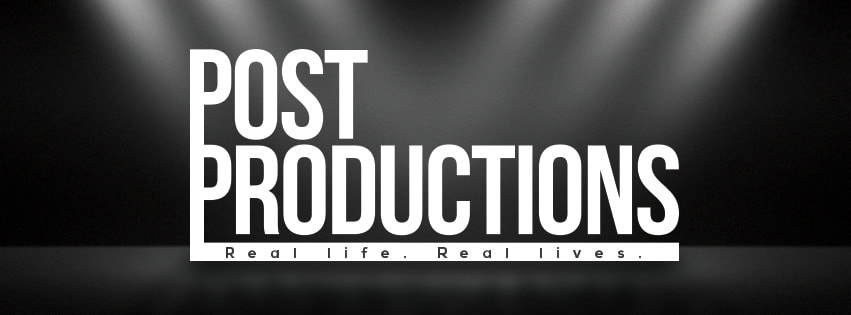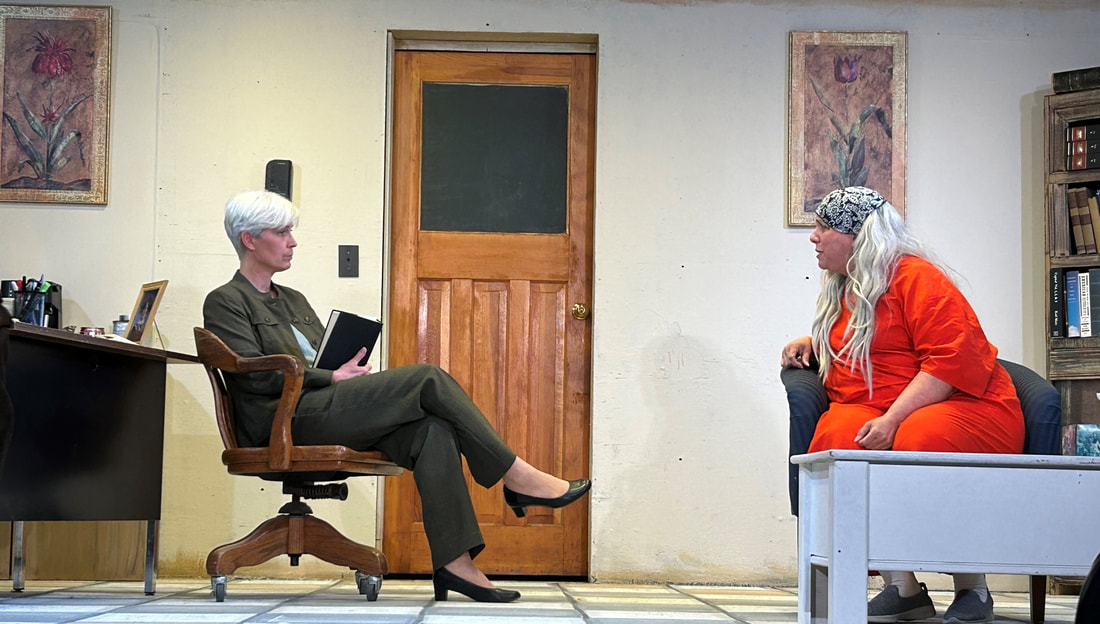|
Actors Shine in Intense and Challenging Play, The Anarchist
by Rebecca S. Mickle REVIEW of The Anarchist by David Mamet. Directed by Michael K. Potter, produced by Fay Lynn and Michael K. Potter, and starring Mary Grace Weir and Cindy Pastorius, as performed at The Shadowbox Theatre on 12 April 2024. Company: Post Productions. Three performances remain: April 18, 19 & 20 at The Shadowbox Theatre (1501 Howard ave. – corner of Howard & Shepherd). 8:00 pm (doors open 7:30). Tickets are $25 via www.postproductionswindsor.ca or cash, debit, or credit card at the MNSi Telecom Box Office (if seats are still available). Two women. One room. One decision. There could be no more perfect venue for David Mamet’s The Anarchist than The Shadowbox Theatre, where a production by Post Productions opened last weekend to a receptive audience. Set in a prison administrative office, a convicted murderer (Cindy Pastorius) pleads her case for parole to a prison reform review officer (Mary Grace Weir). What transpires is a woven tapestry of philosophical notions and misdirection that leaves audiences questioning what’s right and what’s wrong. The tense play takes place in a small office. Tight. Confined. You can taste the tension in the air as the characters parley. In a 60 seat venue like The Shadowbox Theatre, the audience is practically in the room with the women. You feel like you’re witnessing an interaction that should be private. And yet, you’re there listening to every utterance, every misdirection, and every lie. The set is beautifully done. The stage is decorated like any office would be. There is a bookcase full of texts on philosophy and legal code and generic artwork on the walls. The desk has a framed picture and there is a coffee machine in the corner. Files are stacked in the corner and a tissue box is on the table in case these meetings don’t go how the inmates anticipate. Which they often do not. The office is lived-in but not inviting. This is a place where difficult decisions are made. The chemistry between the actors was strong. Pastorius and Weir made the often difficult philosophical language effortlessly conversational in a way that made you feel like you were truly listening to these two women in a meeting. The dialogue, though periodically too quiet, was snappy and quick with the actors perfectly hitting their cues. The moments in the script where Pastorius and Weir were fighting were believable and overwrought as they yelled over top of each other, cutting the other off as one would in an argument. Pastorius played the penitent prisoner, Cathy, with skill. The moments of anger that burst forth from her contrite facade were vibrant and well acted. Weir played Ann with a sense of poise and power that rivaled Pastorius’ Cathy. She gave the character the perfect authoritative presence that commanded the room. Both actors played off of each other well and gave nuanced portrayals of their characters. Congratulations should be given on the staging of such a difficult play. The cast and crew put on an introspective performance that Windsorites should see. The Anarchist can be seen three more times: April 18-20. Tickets can be purchased on Eventbrite or from www.postproductionswindsor.ca. Guest critic Rebecca S. Mickle is the Artistic Director of Windsor Feminist Theatre, and a prolific actor in regional stage, film, and television productions.
0 Comments
|
ARCHIVE
4/18/2024 - THE ANARCHIST - Interview by Marc Rocheleau for Windsorite.ca 4/15/2024 - REVIEW - The Anarchist by David Mamet 4/11/2024 - THE ANARCHIST - Article 4/2/2024 - THE ANARCHIST - Meet the Cast 3/20/2024 - The 2024 Edele Winnie Women's Monologue Competition - Meet the Judges 3/17/2024 - The 2024 Edele Winnie Women's Monologue Competition - Meet the Contestants 3/12/2024 - REVIEW - Vitals by Rosamund Small 3/1/2024 - 4.48 PSYCHOSIS & THE EVENT - Interview with playwright John Clancy 2/19/2024 - 4.48 PSYCHOSIS & THE EVENT - WindsoriteDOTca Interview 2/19/2024 - 4.48 PSYCHOSIS & THE EVENT - 519 Magazine Article 2/13/24 - 4.48 PSYCHOSIS & THE EVENT - Meet the Cast 12/12/2023 - FIRST NIGHT - Interview with playwright Jack Neary 12/5/2023 - Sketchy Jésus and the Questionables 11/2/2023 - THE CASE OF THE ODD SHAPED GAS TANKS - 519 Magazine article 11/2/2023 - REFRAMED - 519 Magazine article 10/14/2023 - HANGMEN - Windsorite article 9/21/2023 - HANGMEN - Meet the Cast 6/21/2023 - MIRABELLA - Trailer 6/6/2023 - MIRABELLA - Interview with playwright Joey Ouellette 6/2/2023 - MIRABELLA - Meet the Cast 4/2/2023 - GLENGARRY GLEN ROSS - Meet the Cast 3/7/2023 - The 2023 Edele Winnie Women's Monologue Competition - Meet the Judges 3/7/2023 - The 2023 Edele Winnie Women's Monologue Competition - Meet the Contestants 1/20/2023 - THE CHILDREN - Meet the Casts 11/25/22 - Pirate Attack on the 1C Bus Going Downtown - Interview with playwright Joey Ouellette 11/19/22 - Pirate Attack on the 1C Bus Going Downtown - Meet the Cast 10/25/2022 - Announcing the winner of THE 2022 WINDSOR-ESSEX PLAYWRITING CONTEST 9/28/2022 - STUCK - Interview with playwright Jonathan Tessier 9/14/2022 - STUCK - Meet the Creative Team / Cast 8/22/2022 - A GREAT ROUND WONDER - Interview with playwright Barry T. Brodie 8/9/2022 - A GREAT ROUND WONDER - Meet the Cast 6/5/2022 - PREPARED - Meet the Cast 5/31/2022 - PREPARED - Interview with playwright Kari Bentley-Quinn 4/19/2022 - Interview with playwright Edele Winnie 11/10/2021 - DEAD BEAR - Meet the Cast 11/5/2021 - DEAD BEAR: Interview with playwright John Gavey 9/12/2021 - BLASTED: Meet the Cast 7/2/2021 - CRIMINAL GENIUS: Meet the Cast 3/10/2021 - NEGATUNITY: interview with playwright Matthew St. Amand 3/10/2021 - NEGATUNITY: Meet the Cast 11/16/2020 - THE BEAUTY QUEEN OF LEENANE: Meet the Cast 10/5/2020 - FATBOY: interview with playwright John Clancy 7/16/2020 - Winner: 2020 Playwriting Contest 6/23/2020 - Announcement: Nikolas Prsa joins Post as Outreach Director 3/15/2020 - BETRAYAL - Meet the Cast 1/18/2020 - PRY IT FROM MY COLD DEAD HANDS: interview with playwright Edele Winnie 1/15/2020 - PRY IT FROM MY COLD DEAD HANDS: Meet the Cast/Crew 11/4/2019 - THE PILLOWMAN: Meet the Cast/Crew 9/18/2019 - AUTOPSY & A HAUNTING IN E FLAT: interview with playwrights Alex Monk & Joey Ouellette 8/29/2019 - AUTOPSY: Meet the Cast 8/29/2019 - A HAUNTING IN E FLAT: Meet the Cast 5/31/2019 - AMERICAN BUFFALO: Meet the Cast 3/31/2019 - NOTHING BUT THE TRUTH: Meet the Cast 3/19/2019 - NOTHING BUT THE TRUTH: interview with playwright Eve Lederman 2/25/2019 - So You're Writing a Play... 1/17/2019 - NO EXIT: Meet the Cast 11/22/2018 - ANOTHER FUCKING CHRISTMAS PLAY...: Meet the Cast & Composer 8/28/18 - EQUUS: Meet the Cast/Crew 7/15.2018 - SHELTER IN PLACE: Meet the Playwright 7/9/2018 - SHELTER IN PLACE: Meet the Cast 7/2/2018 - Writing to be Read 5/3/2018 - STOP KISS: Meet Fay Lynn as Callie 4/10/2018 - STOP KISS: Meet Lauren Crowley as Sara 4/27/2018 - STOP KISS: Meet Dan MacDonald as George 4/25/2018 - STOP KISS: Meet Matt Froese as Peter 4/21/2018 - STOP KISS: Meet Cindy Pastorius as Mrs. Winsley / Nurse 4/18/2018 - STOP KISS: Meet Alex Alejandria as Detective Cole 1/24/2018 - DOUBT: Meet Niki Richardson as Sister Aloysius 1/17/2018 - DOUBT: Meet Eric Branget as Father Flynn 1/10/2018 - DOUBT: Meet Carla Gyemi as Sister James 1/3/2018 - DOUBT: Meet Jennifer Cole as Mrs. Muller 10/2/2017 - TRUE WEST: Joey Wright as Austin 9/25/2017 - TRUE WEST: Dylan MacDonald as Lee 9/18/2017 - TRUE WEST: Ian Loft as Saul 9/11/2017 - TRUE WEST: Cindy Pastorius as Mom |
Copyright © 2017


